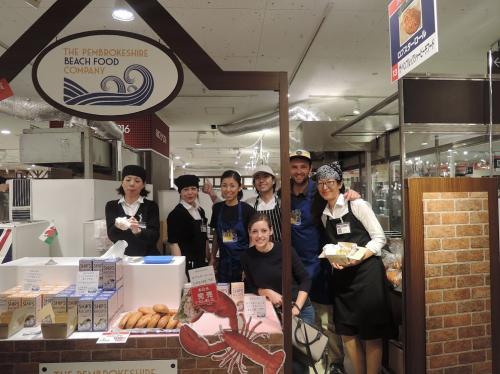
LAND OF THE RISING SUN (AND SEAWEED)
Written by Fran Barnikel
Arriving at the airport in Osaka the first thing to note was that our luggage arrived on the conveyor belt before we’d even found the conveyor belt. Anyone that’s ever been on a flight ever, will know how unusual that is, especially a thirteen hour one with a change in Amsterdam. This teamed with the efficient way in which each and every one of us was photographed and had our fingerprints scanned was a good indication of the clockwork way the entire country ran as we’d soon see.
Our incentive for being in Japan was simple. To experience one of the only places on earth where seaweed is almost as common as salt and pepper. We wanted to figure out the reason why it's so fundamental in the Japanese diet and to see how seaweed might fit into the UK diet at home. To make a splash in the Japanese media and gain some good business relationships would be a fantastic bonus.
How it came about was this. Over a year prior to setting down on Japanese soil a friendly gentleman called Keiji came to say hi to us at a trade event in London. Gratefully this wasn’t the last we saw of Keiji, after numerous meetings with him and others we were asked to attend the “British Fair” at Hankyu department store where we would provide our famous lobster rolls, Welsh Breakfasts and Welsh rarebit.
The first evening of our exceptionally long first day (Japan is eight hours ahead of the UK) was spent at a traditional Japanese tavern where a group of people named the St Davids Society. They had been in contact before we arrived and invited us for a feast. I’ll forgive you, if like me, you may have pictured some sort of bar after hearing the word tavern. This place was certainly nothing like a pub. After removing our shoes we were led through sliding doors into a private room with a low table, soon the table was filled as consecutive plates of different pickled vegetables, noodles, sushi and green tea arrived. Our hosts, also known as the ‘Friends of Wales’ welcomed us to Osaka for no gain of their own other than to befriend us. They insisted after we ate, that we all sing a traditional Welsh song together. I can only apologise to Chikako and her lovely group for our disappointing rendition of ‘Keep a Welcome in the Hillside’. We all made a promise to make sure we learned the words once we got home…
The Hankyu Department store welcome reception gave us our second taste of Japanese hospitality. Once more we were offered lots of exquisite food and champagne in a fancy room near the top of the shop building. I should take this time to explain the enormity of the Hankyu Department store. It’s huge. It’s thirteen floors of magnificent, immaculate, shopping splendour, where every square food is manned by a member of staff, staff who bow when they enter a space whether there are customers there to see them or not. I must thank Mr Kumawara, owner of the store for his kind hospitality that evening and especially for the curious magic show which took place mid-way through what was otherwise one of the more formal evenings I’ve ever had.
One of the most interesting cultural differences struck us as the reception ended. It was announced that we were to say goodbye, the lights went up and we were ushered away. It said in the itinerary, the Japanese people live for a good itinerary, that the reception would end at 9pm and that was exactly what happened. We didn’t finish our drinks, or even our conversation. It was a fantastic example of things running like clockwork as I mentioned before.
Outside on the street, it too felt heavily staffed. There would be up to four traffic managers on a crossing, normally older gentlemen, immaculately dressed in formal uniform, waving and gesturing when and where to walk to avoid the traffic, which would be flowing in five or six lanes in the middle of the busy city. Not one person would ever dare cross the road without the say so of the automated lights or the crossing guides. What’s nice about this is that those men had a purpose and a place. There seemed to be a huge amount of respect among people and although money was visibly everywhere, no one appeared to see themselves as above anyone else and everyone was polite.
Fashion in Osaka was amazing. Flat shoes are simply not a thing by the seems of it and the pride that people take in their appearance mirrors the mutual respect they have for others and themselves. Tourists stick out like foxgloves in a rose garden because wearing something which may be very nice in our western world looks almost crass in Japan. I’m told that the seasons are taken very seriously too, so despite the 27 degree heat, to wear shorts in October is unheard of. October is very much an autumn month and only autumn attire will do.
After a day of absorbing some of this beautiful place nothing could have prepared us for opening day at the Hankyu British Fair. There was an extremely formal opening ceremony which involved our own AM Ken Skates, the British consulate general, a full brass band and some golden scissors. When the doors opened we stood to attention whilst women ran in. Yes, they literally ran. They ran to queue for scones with jam and cream, they ran for fish and chips and some even ran to get to our lobster rolls or Welsh breakfasts.
All day every day we manned two stands on the ninth floor. The crowds were surreal, you didn’t leave your spot unless you had to for fear of being taken by the current of people and having to fight your way back. The hour long queues only began to ease off on around day four of five and right at the end of the event the people at Hankyu continued their welcome and gratitude to us with a thank you dinner. By this point we were unphased by all things raw, all things which looked like one thing and tasted like another and all kinds of textures, almost inexplicable. The food was fantastic and the evening was made even better by a dance routine we were challenged to learn. The steps were all about happiness and respect and we were shown what to do by one of the top managers at the store.
Our group learned a lot. Most importantly we touched the surface of the Japanese people’s relationship with food and the seaweed in that food which is something we’ll take home and draw upon where we can. It’s hard to get your head around a nation who apparently tend to eat out rather than in. Where recommendations and crazes are immensely powerful and where convenience food is abundant but where you rarely see anyone eat it. Small appetites and beautifully presented restaurants or casual dining seemed to be key.
There is so much to say about the land of the rising sun and so many people to thank for contributing to our time there that I cannot say it all short of this becoming my own personal travel blog. I will end it here and just say this. Japan, I love your style, your attitude, your weather. I love your systems, etiquette and your second to none customer service. I love that you have several storeys of shops underground and shopping malls longer than every road in Pembroke aligned. I love your neon lights and crazy girl bands on the street. I love that small businesses can somehow sit beside big ones and still thrive. I love how safe it feels on your super clean street and i love that even leaves are hurriedly swept away the moment they fall to keep up your pristine appearance.
I love the people, the food, and your love of fun.
Japan you were fantastic.


